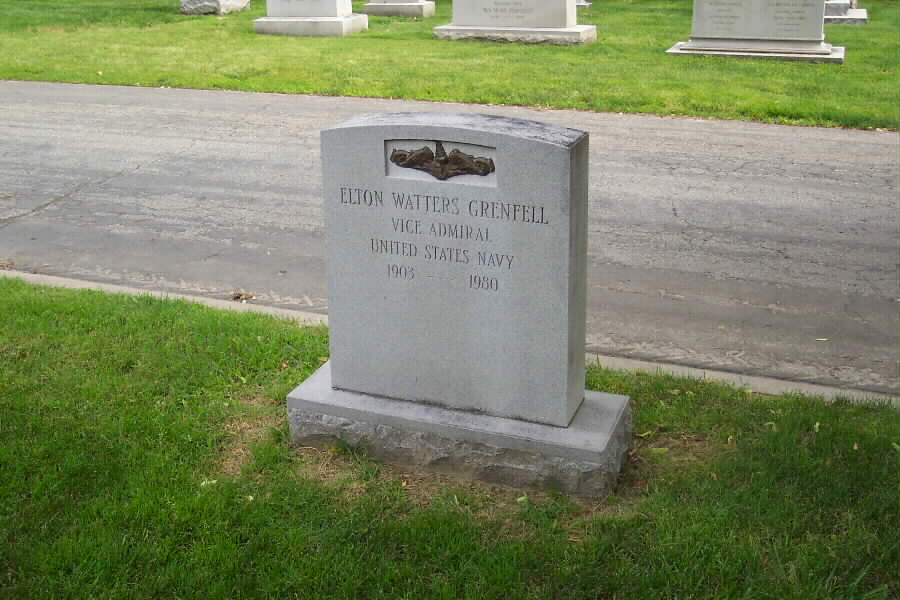Elton Watters Grenfell attended Durfee High School in Fall River, and entered the U.S. Naval Academy, Annapolis, Maryland, from the Fifteenth District of Massachusetts on June 17, 1922. While a Midshipman he was a member of the Track Squad and on the staff of the “Lucky Bag.”
He was graduated and commissioned Ensign on June 3, 1926, and through subsequent promotions attained the rank of Captain, to date from August 1, 1943.
His selection for the rank of Rear Admiral was approved by the President on 24 July, 1953, his date of rank January 1, 1954. On 21 July 1960, the President approved nomination to rank of Vice Admiral as Commander Submarine Force, U.S. Atlantic Fleet.
After graduation in 1926, he remained at the Naval Academy for the summer course in aviation, and in September joined the USS Florida. he was detached in June 1927 with orders to the Naval Torpedo Station, Newport, Rhode Island, where he completed the course in torpedoes in December 1927. During the next six months he served in the USS Lexington and the USS Childs. From July until December 1928 he had instruction in submarines at Submarine Base, New London, Connecticut, and then served in the submarine R-4 based in Honolulu, Territory of Hawaii, and New London, Connecticut, until 1933. In July 1933, he reported to the Postgraduate School, Annapolis, Maryland, for instruction in Mechanical Engineering. Continuing the course at the University of California, Berkeley, California, he received the degree of Master of Science from the latter in 1936.
After duty in connection with fitting out the USS Pickerel at the Electric Boat Company, Groton, Connecticut, he joined her when she was commissioned on January 26, 1937, and served aboard until May 1939. He was next ordered to duty in the Bureau of Engineering, Navy Department, Washington, D.C., and during his tour there that Bureau was combined with the Bureau of Construction and Repair, and re-designated the Bureau of Ships, in June 1940. During this tour he was primarily responsible for the procurement and development of the first LCVP’s and Higgins landing boats. He reported in February 1941 for duty in connection with fitting out the USS Gudgeon building at the Mare Island Navy Yard, and assumed command when that submarine was commissioned on April 21, 1941. The USS Gudgeon was the first submarine to go on war patrol from Pearl Harbor, departing Pearl Harbor on December 11, 1941. Injured in an airplane crash, he was detached from command of the Gudgeon in June 1942. He commanded the USS Tunny from August to December 1942.
He then reported for duty as Strategic Planning Officer on the staff of the Commander Submarine Force, Pacific Fleet. He was in command of Submarine Division Forty Four of Submarines, Pacific Fleet, for ten months, and on June 1, 1945, assumed Command of Submarine Squadron Thirty Four. Following the war he commanded Submarine Squadron Five from September 2, 1945 to August 1946. Upon his return to the United States from the Pacific Area in August 1946, her reported for duty in the Office of the Chief of Naval Operations, Navy Department. He served as the Assistant Deputy for Undersea Warfare, Submarines, and also as the Submarine Member of the Ship Characteristics Board. In July 1948 he was sent again to the Pacific as Assistant Chief of Staff for Plans to Commander Submarine Force, U.S. Pacific Fleet. On October 31, he attended the Industrial College of the Armed Forces, Washington, D.C. and was President of his class.
From June 1953 until August 1953, he commanded Submarine Flotilla One, after which he had duty in the Bureau of Naval Personnel, Navy Department, where he served as a Special Deputy to the Chief of Naval Operations. On July 13, 1954 he became Deputy to the Assistant Chief of Naval Personnel in connection with Military Personnel Security with additional duty as Assistant Chief of Naval Operations (Military Personnel Security), and in June 1955 was designated Assistant Chief of Naval Personnel for Personnel Control, with additional duty as before. On August 31, 1956 he assumed duty as Commander Submarine Force, U.S. Pacific Fleet.
Michael Robert Patterson was born in Arlington and is the son of a former officer of the US Army. So it was no wonder that sooner or later his interests drew him to American history and especially to American military history. Many of his articles can be found on renowned portals like the New York Times, Washingtonpost or Wikipedia.
Reviewed by: Michael Howard

